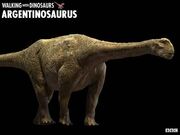Template:Dinoseries

A contrast of two sauropods - a brachiosaurid Brachiosaurus on the left and diplodocid Diplodocus on the right. (WWD images' compilation)
The Sauropodomorpha dinosaurs are a branch of Saurischian, or lizard-hipped dinosaurs, and are close cousins to the carnivorous theropods; however, their own diet was herbivorous, like that of the ornitischia dinosaurs (ceratopsians and co.).
Most of the Sauropodomorpha dinosaurs had long necks and tails, pillar-like legs and relatively small heads with jaws full of peg-like teeth. Despite casual seperation, two groups of Sauropodomorpha dinosaurs, the Prosauropods and the Sauropods proper, where not tow seperate groups. "Prosauropods" like Massospondylus and Plateosaurus lived during the late Triassic and early Jurassic time periods; Sauropods - during the late Jurassic and Cretaceous.
Grazing plateosaurs.
Featured in the first episode of Walking with Dinosaurs, Plateosaurus was a typical prosauropod dinosaur: at 8-9 meters in length, it towered over other early dinosaurs, such as Coelophysis, who was featured at the end of that episode, when the herd of plateosaurs arrived at the start of the wet season. Such prosauropods replaced Placerias and other reptilian plant-eaters. Some theorise that as time went on, they got too small to compete with their sauropod cousins, while such ornitischians as Stegosaurus possessed a superior digestive system, and together the sauropods and the bird-hipped dinosaurs drove the prosauropods to extinction. Another theory is that as the Jurassic climate became cooler and wetter, the prosauropods, which were pre-adapted to a more arid climate, were unable to cope, and died out.).
Diplodocus (a diplodocid) and Brachiosaurus (a brachiosaurid) were also featured in Walking with Dinosaurs, the second episode. They were considerably larger than their extinct prosauropod cousins (this episode took place in late Jurassic, almost a 100 million years after the previous one), and differed sharply from each other. The diplodocids (such as Diplodocus and its cousin Apatosaurus featured in a cameo in Allosaurus: Walking with Dinosaurs Special) were longer than taller, they (Referring only to these two, not all diplodocids/oids.) fed on relatively low-growing vegetation, and were unable to raise their heads fat above their shoulder level. Their tails were especially long, thin and whip-like. In the second episode of Walking with Dinosaurs, the narration was centered around the life cycle of the diplodocid Diplodocus, how it was hatched, lived and died during the late Jurassic. (It also had a cameo appearance in the closing credits of the last episode of Walking with Monsters, demonstrating a Mesozoic world ruled by dinosaurs).
That episode also featured (in a cameo) the brachiosaurid Brachiosaurus, contrasting it with Diplodocus along the way. Unlike the diplodocids, the brachiosaurids were built more like modern-day giraffes, with front legs and shoulders higher than hind legs and the rear end; and the long sauropod neck made the brachiosaurids even taller. Unlike the diplodocids and other big herbivores of late Jurassic,such as Stegosaurus, brachiosaurids fed on especially high-growing vegetation, as they demonstrated in "Time of the Titans".

Apatosaurus. (App image.)
The third branch of the Jurassic sauropods were camarasaurids, such as Camarasaurus, feated in Walking with Dinosaurs: Inside their World app. Camarasaurids were similar to brachiosaurids and belong to the same group of Macranaria, but were in general smaller than the brachiosaurids and had special hollow chambers in their bones, aimed to lessen the animals' weight.
By the time of the Cretaceous, however, both the diplodocids and the macronarians (brachiosaurids and camarasaurids) had died out, unable to cope with the shrinking landmass and the competition from the new, more advanced ornithiscians (something that was hinted at in the fourth episode of Walking with Dinosaurs). The titanosaurs, however, flourished. Argentinosaurus, featured in the first episode of Chased by Dinosaurs, was probably one of the biggest titanosaurs and one of the biggest dinosaurs to have ever lived. The episode "Land of the Giants" followed the migration of one such herd (earlier sauropods featured in Walking with Dinosaurs and Allosaurus were shown migrating from place to place as well), as well as their contribution to Cretaceous South American ecosystem.

Argentinosaurus. (Official image.)
Just like the other dinosaurs, the last Sauropodomorpha dinosaurs, the titanosaurs, died out during the K/T Extinction 65 MYA.
Camarasaurus skeleton. (Wiki image.)
